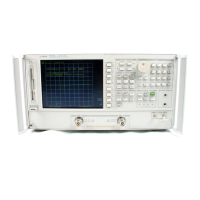the next terminator. The analyzer also interprets line
feeds and HP-ID END OR IDENTIFY (EOI) messages as
terminators.
Syntax Types
The specific syntax types are:
SYNTAX TYPE 1: [code] [terminator]
These are simple action commands that require no complementary
information, such as
HIJTO
j
(autoscales the active channel).
SYNTAX TYPE 2:
[code][appendage][terminator]
These are simple action commands requiring limited customization,
such as
I~ORROH;
and
COF:ROFF;
(error correction ON or OFF) or
REI:H
1;
,
REC:AZ
3
,
FF:ElZH:::
;
(recall register 1, 2, 3). There can be no
characters or symbols between the code and the appendage.
Note
In the following cases:
CLEAREG[D],
RECAREG[D],
SAVEREG[D], and EG[D], [D] must be 2 characters.
For example,
l:LEHFEl33
1
j
will execute, while
CLEHIIEG
1; will generate a syntax error.
SYNTAX TYPE 3: [code] [data] [unit][terminator]
These are data-input commands such as
:STAR
1.8
GHZ;
(set the
start frequency to 1
GHz).
SYNTAX TYPE 4: [code] [appendage] [data] [terminator]
These are titling and marker commands that have an appendage,
such as
TITF:l
“STHTEl”
(title register 1
STATEl),
TITF:Z
” TEST2
”
(title register 2
TESTB).
QUERY SYNTAX: [code]
[?]
lb query a front-panel-equivalent function, append a question
mark
(?)
to the root mnemonic. (For example,
POCIE?‘,
t?v’E~:O?,
or
f?EAL?.)
‘lb query commands with integer appendages, place the
question mark after the appendage.
HP-IB Programm~
‘ng and Command Reference Guide
l-
11

